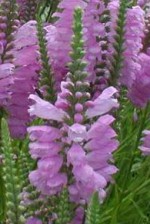 Also known as false dragonhead, this rhizomatous herbaceous perennial is native to North American and a member of the deadnettle family, Lamiaceae, that also includes mint, coleus, and lamb’s ear. The plant has creeping stems that are square in cross section and carry coarsely-toothed, lanceolate leaves three to six inches long. The lilac-pink, one inch flowers are produced in late summer on spikes 1-1 ½ feet long, are two lipped, and resemble the flowers of snapdragons. They have the curious characteristic of temporarily remaining in the position on the stem to which they are moved, giving raise the common name, obedient plant. Unfortunately the plants are not obedient and tend to flop in rich soil as well as spread with abandon. The generic name, Physostegia, comes from the Greek words physa meaning a bladder, and stege, meaning a covering, referring to the calyx which inflates as it becomes full of fruit.
Also known as false dragonhead, this rhizomatous herbaceous perennial is native to North American and a member of the deadnettle family, Lamiaceae, that also includes mint, coleus, and lamb’s ear. The plant has creeping stems that are square in cross section and carry coarsely-toothed, lanceolate leaves three to six inches long. The lilac-pink, one inch flowers are produced in late summer on spikes 1-1 ½ feet long, are two lipped, and resemble the flowers of snapdragons. They have the curious characteristic of temporarily remaining in the position on the stem to which they are moved, giving raise the common name, obedient plant. Unfortunately the plants are not obedient and tend to flop in rich soil as well as spread with abandon. The generic name, Physostegia, comes from the Greek words physa meaning a bladder, and stege, meaning a covering, referring to the calyx which inflates as it becomes full of fruit.
Type: Herbaceous perennial
Bloom: Lilac pink, two-lipped flowers produced in late summer on spikes 1-1 ½ inches long
Size: 3-4’ H x 3’ W
Light: Full sun but tolerates some shade
Soil: Fertile, moist, well-drained, acidic
Hardiness: Zones 2-9
Care: May need staking; control spread; divide every 2-3 years
Pests and Diseases: None of significance
Propagation: Self-seeds, stem cuttings in early summer
Companion plants: Asters, boltonia, phlox, meadow rues, bonesets, goldenrods, sunflowers, ornamental grasses
Outstanding Selections:
Var. alba (white, early blooming)
Var. grandiflora (large flowers, taller than species)
Var. nana (12-18” H)
‘Pink Bouquet( bright pink, 3-4’ H, meeds staking)
‘Summer Snow’ (white, 3’ H, less invasive and earlier than species)
‘Variegata’ (leaves with white edges)
‘Vivid’ (vibrant pink flowers, 2-3’ H, compact, upright)